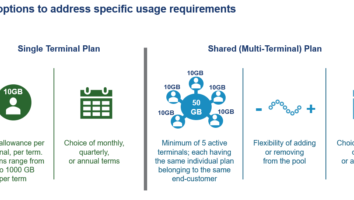For disaster relief and emergency response teams, time is of the essence. A disaster is often measured in minutes: a small window of opportunity during which lives can be saved and property, such as land, forestry and natural habitats, can be protected. Delays in response could potentially mean the difference between life and death.
This urgency makes the rapid, reliable deployment of communication networks for emergency response teams and humanitarian aid groups especially critical. To ensure the swiftest and most dependable response possible, first responders need access to an on-demand, fail-proof connectivity solution that is easy to deploy.
As the connectivity transformation continues, solution partners (SPs) bringing connectivity to first responders can guide their end users into this new era with FlexMove. Powered by the award winning Intelsat Epic high-throughput satellite (HTS) fleet, this global, end-terminal managed service makes it easier than ever for first responders to access always-on connectivity anywhere their mission takes them, no matter how remote or hostile the location.
Natural Disasters wreak havoc on traditional networks
Earlier this year, Australia was ravaged by its worst wildfires in decades. Emergency responders spent months battling more than 15 million acres of scorched land. The fires damaged several fixed wireless towers and fiber-optic cables in New South Wales and Victoria, severely limiting first responders’ efforts to communicate effectively. Dozens of people died, and scientists estimated that 500-800 million animals perished as a result of the fires.
Meanwhile, hurricane and typhoon season has begun, with meteorologists forecasting aboveaverage activity in the Atlantic and Pacific Oceans. In particular, the U.S. National Oceanic and Atmospheric Administration (NOAA) predicts up to six major hurricanes with 10 anticipated in the Atlantic ocean alone. In previous years, Hurricanes Harvey, Sandy and Maria knocked out 70-90% of the cellular networks in the hurricanes’ path. These outages delayed response times while leaving emergency responders scrambling to gather and relay mission-critical information.
No matter what kind of disaster or mission-critical operation may arise, organizations worldwide are thinking of ways to better prepare themselves for seasonal and unexpected events. Unfortunately, traditional communication networks won’t meet the evolving needs of first responders and humanitarian aid groups.
As history has shown us, cellular networks often become degraded and overwhelmed, causing outages or unreliable communications, at best, during an emergency. A resilient network is of critical importance during disaster-response planning. Rapid network deployment, dedicated network resources and a redundant, fail-safe solution are all crucial elements for first responder communications.
Intelsat FlexMove — An HTS solution at your fingertips
The global FlexMove network extends the boundaries of terrestrial networks cost-consciously, while delivering data rates that far surpass mobile satellite services (MSS). With always-available network resources, FlexMove delivers ubiquitous, high-speed satellite connectivity up to 20 times faster than legacy MSS solutions for a fraction of the cost.
First responders demand connectivity choices that allow them to deploy the most optimal solution at any given time considering variables, such as reliability, coverage and expense. By augmenting existing solutions, FlexMove provides a seamless and simple way to integrate HTS into an SP’s connectivity solution suite.
Intelsat has simplified access to the FlexMove service by pre-qualifying a portfolio of innovative terminals. Whether you need connected mobility or portable connectivity, FlexMove has an appropriate terminal that is pre-configured to network specifications enabling easy access from any location. Virtually anyone can set up and get connected with FlexMove in just minutes without prior technical training.
- Connected Mobility: Communications-on-the-Move (COTM) terminals for installation and use on
moving vehicles, capable of delivering data speeds up to 5×2 Mbps. This solution is ideal for
ambulances, paramedics, mobile command and test centers. - Portable Connectivity: Communications-on-the-Pause (COTP) terminals for temporary use in a
fixed location that are lightweight and compact empowering end-users to simply “grab and go.”
With speeds up to 10×3 Mbps, disaster relief crews have connectivity for temporary clinics and
test facilities, field hospitals, plus food and medicine distribution.
The FlexMove end-to-end managed service can decrease response times significantly because users
won’t waste valuable time trying to set up the terminal or manage the network.
How Intelsat has helped first responders
In 2017, Hurricane Maria cut a swath of destruction across the Caribbean. During disaster recovery efforts in Puerto Rico, Intelsat partnered with mobility solution provider Kymeta to power three emergency vehicles with resilient, high performance connectivity from the Intelsat Epic HTS network. Using Kymeta’s roof-mounted electronically steered flat panel antennas, the two partners were able to:
- Provide FEMA workers with reliable internet access
- Connect banks and pop-up ATMs so that cash could be dispensed to residents
- Grant pharmacists’ access to online medical records to fill dwindling prescriptions for residents in need
- Deliver VoIP connectivity so residents could check-in with family and friends worldwide
Watch the Kymeta video about connecting Puerto Rico
Two years later, Category 5 Hurricane Dorian devastated large parts of the Bahamas, damaging critical communications services, which severely impacted logistics and resource coordination for mission-critical operations. Within 24 hours, the Intelsat Epic network enabled quick and easy connectivity services, allowing first responders to:
- Provide mobile medical services
- Assist communities with logistics and debris management
- Establish communications with the U.S. mainland to further coordinate relief efforts
As the world continues to deal with historic natural disasters and continued uncertainty, it’s imperative the first responder community has access to easily deployable, high-performance connectivity now more than ever.
Related Posts

Blog
Introducing FlexMove – A New Era of Land Mobility Connectivity
June 05, 2020
News Release
February 18, 2020Related Posts

Blog
Powering and Accelerating the True Virtualization of Space April 04, 2023




